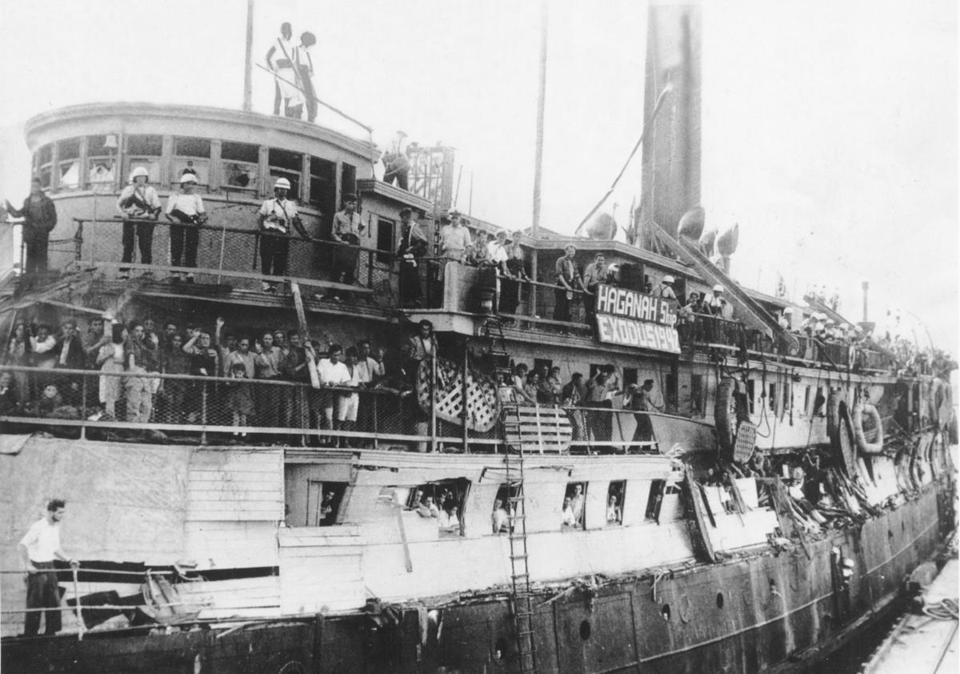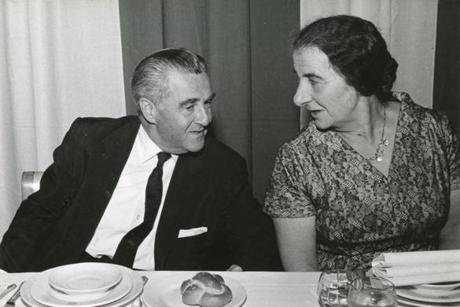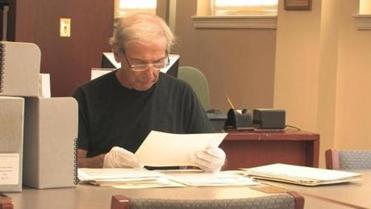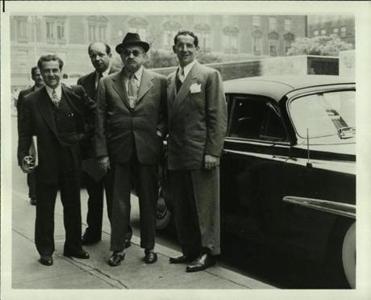
Jewish refugees pack the ship Exodus in 1947 in a futile effort to reach British-controlled Palestine.
When most people think of the refugee ship Exodus, the Paul Newman movie and the Leon Uris novel on which it was based come to mind.
What few know is that one of the real heroes behind the real Exodus was a businessman from Brockton, Dewey D. Stone.
Stone’s role in purchasing ships and weapons — under the nose of the FBI — and helping to orchestrate the founding of Israel is the subject of a new documentary, “The Dewey Stone Connection: From Exodus to Independence.”
The film is the result of a five-year effort headed up by Walter M. Newman, who grew up a few blocks from Stone’s house.

Dewey D. Stone with Golda Meir, taken in November 1958. Meir became prime minister of Israel in 1969. American Jewish Historical Society, New England Archives
Newman — a retired official with the Environmental Protection Agency who helped supervise the Boston Harbor cleanup — was researching the founding of Israel and noticed that Stone’s name “kept popping up,” he said recently. “I decided to investigate what the heck Dewey had been doing.”
Newman scoured the records at the American Jewish Historical Society office in Boston, where Stone’s papers are archived. “There were so many things, so many wonderful things,” he said. “It was an eye-opening experience.”
The Stone that Newman recalled from his youth was a charismatic leader in the Jewish community, hardly the kind of person one would expect to be part of what amounted to a smuggling ring. “There were whispers around Brockton that he was somehow involved with the state of Israel, but nobody knew exactly what he was involved in,” said Newman, 76, who now lives in Sharon and Florida.
Stone became captivated by Palestine after hearing a speech in Boston in 1940 by Chaim Weizmann, the head of the World Zionist Organization and later the first president of Israel. A renowned chemist, Weizmann was drumming up support for a research university in a future Jewish state.
After his talk, Weizmann invited Stone and a few others back to his hotel room, where they chatted until the wee hours of the morning. The next day, Stone drove Weizmann to Harvard, where he was giving another speech. On the way, they stopped in front of MIT — the very model of the university Weizmann sought to build.

Walter M. Newman doing research at the American Jewish Historical Society office in Boston on the Dewey Stone project. Michael Traub
“It was at that moment that the seed of hope that this dream might really be achieved was planted within me — sitting in a stationary car with a silent visionary,” Stone wrote, as quoted in the documentary.
After the war, as the full extent of the Holocaust became apparent, Stone worked behind the scenes on both military and diplomatic efforts to forge a Jewish state. He teamed up with a fellow Massachusetts businessman, Harry Levine of Leominster.
Suspecting that the FBI was tapping his phone, Stone made calls from his sister’s house to procure ships and surplus US weapons. In the documentary, nephew Ted Teplow, of Cambridge, recalls being up in his bedroom doing homework and overhearing his uncle on the phone. “We were all told not to talk about it,” Teplow, now 84, said in an interview with the Globe.
Unlike in the 1960 movie, the real Exodus, carrying Holocaust survivors from France to Palestine in 1947, was rammed by a British destroyer just a few miles off the coast of Palestine, then under British control. Its 4,500 passengers were sent to a displaced-persons camp in Germany, the very nation that had persecuted them. Eventually, the majority of them settled in Israel. Meanwhile, worldwide outrage over the refugees’ plight helped bolster the push to partition Palestine into Jewish and Arab states.
Stone played an important role in that push as well. His brother Judge Harry K. Stone had become acquainted with Anastasio Somoza when the Nicaraguan dictator was in Boston for surgery in the 1930s. At the time, the Stone family owned Converse Rubber Co., maker of raincoats and shoes (and later, most famously, Chuck Taylor sneakers).
The brothers thought it would be good publicity for the company to host a reception for Somoza there, complete with motorcade, band music, and State Police escort, Teplow told the Globe. Somoza, who had been miffed that the US government had ignored his presence, was delighted by the attention and became close friends with Judge Stone, naming him honorary consul. That relationship paid off a decade later when Dewey and Harry Stone enlisted the Somoza regime to rally Latin American support that proved crucial for UN approval of the partition plan.

Dewey Stone (left) with Chaim Weizmann (center, with hat), head of the World Zionist Organization and later the first president of Israel. Chaim Weizmann Institute of Science
But just a few months before Israel was to declare independence, the State Department had persuaded President Harry S Truman to reject recognition. Truman went so far as to shut the White House doors to Zionists.
Weizmann, who was waiting anxiously in New York, expressed his frustration to Stone in a meeting on March 12, 1948. That night a visibly shaken Stone returned to Boston, where he was honored at a B’nai B’rith dinner along with Frank Goldman, the national head of the organization.
Goldman asked Stone what was the matter. Hearing about Weizmann’s predicament, Goldman said he might have a solution. He had just attended a Kansas City B’nai B’rith event recognizing Eddie Jacobson, who had been Truman’s partner in a clothing store business. Why not see if Jacobson would intervene with his old pal, Goldman suggested.
After collecting coins for a pay phone from fellow dinner guests, Goldman and Stone hustled into the lobby to call Jacobson. Stone arranged to meet Jacobson in New York and introduce him to Weizmann. Realizing the gravity of the situation, Jacobson hopped on a train to Washington to meet with Truman. The president agreed to see Weizmann, provided he came in the side door.
After hearing out the Zionist leader, Truman did an about-face and recognized Israel.
Weizmann “was a wonderful man; he was a leader, one of a kind you read about but seldom see,” Truman says in a remarkably candid interview he gave after leaving office and which is included in the documentary.
Newman found the footage through the Harry S Truman Library and Museum. “To have the president of the United States tell the story firsthand — that was magnificent,” Newman said.
After the war, Stone continued to support Israel through numerous national leadership posts in the Jewish community. Perhaps dearest to him was the Chaim Weizmann Institute of Science, serving as the founding chairman of its board of governors from 1949 through 1970.
Coincidentally, the director of the documentary, Michael Traub, grew up on the Weizmann campus, the son of a professor. Traub, 47, recalled that as a child he walked past the Stone Administration Building every day, without knowing anything about its namesake.
Building on Newman’s work, Traub plowed deeper into Stone’s story. For the film he interviewed Stone’s large extended family and local Jewish leaders. Traub, who now lives in Jamaica Plain, traveled back to Israel as part of his research. He interviewed Suzy Eban, widow of Abba Eban. The famed Israeli diplomat had often stayed at Stone’s house, Traub said.
The filmmaker said that as a student in Israel he was taught little about the role of American Jews in helping to found the Jewish state. He said they had to remain in the shadows for fear of running afoul of US laws against supplying foreign belligerents and of fanning anti-Semitism. The ship Exodus, for example, was purchased by a front organization, the Weston Trading Company, of which Stone was the sole stockholder.
Stone died in 1977 at age 77. He and his wife, Anne, had no children, but their 17 nieces and nephews considered the couple their second parents.
“He was very charming,” Teplow said in an interview. “Very short, about 5-foot-3, but very handsome.” Stone knew how to work a crowd, his nephew added. “There would be 50 people at an affair, and in the course of an evening he would be eyeball-to-eyeball with everybody . . . and in those few minutes you were the most important person in the world.”
The documentary, which was financed in part by the Stone family foundation, was edited to under 45 minutes, short enough to be shown during a class period. Newman and Traub would like to screen it at Jewish day schools and film festivals, as well as possibly on a Jewish television network.
Click here for article.
